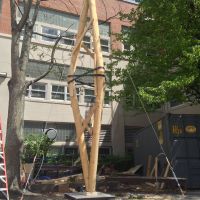Tag: structural-systems
-
 Design, mechanics, and optimization of interlocking wood jointsResearch, 2017 - Present
Design, mechanics, and optimization of interlocking wood jointsResearch, 2017 - PresentDespite the longstanding craft of interlocking wood joints in North American and East Asian carpentry, modern timber structures frequently use metal connectors in mid-rise construction. This research explores the structural capabilities of interlocking joints between beams and columns for mid-rise timber frame construction. Research methods include parametric design, structural modelling, digital fabrication, and experimental load testing.
-
 Whole-timber structural systemsResearch, 2014 - 2015
Whole-timber structural systemsResearch, 2014 - 2015Trees, when used as structural elements in their natural, round form, are up to five times stronger than the largest piece of dimensioned lumber they could yield. Additionally, these whole-timbers have a lower effective embodied carbon than any other structural material. When combined into efficient structural configurations and joined using specially-engineered connections, whole-timber has the potential to replace entire steel and concrete structural systems in large-scale buildings, bridges, and infrastructure. Whole-timber may be the most appropriate structural solution for a low-carbon and fully renewable future in both developed temperate regions and the developing Global South. To reduce barriers to adoption, including project complexity and cost, a standardized “kit of parts” in whole-timber is proposed. This project proposes new designs for the first and most important element of this kit: a structurally independent column in whole-timber. A 20’ compound column in whole-timber is prototyped at full-scale. New, simple calculation methods are developed for estimating the buckling capacity of tapered timbers. Based on conservative assumptions, the embodied carbon of whole-timber column systems is shown to be between 30% and 70% lower than conventional steel systems.


